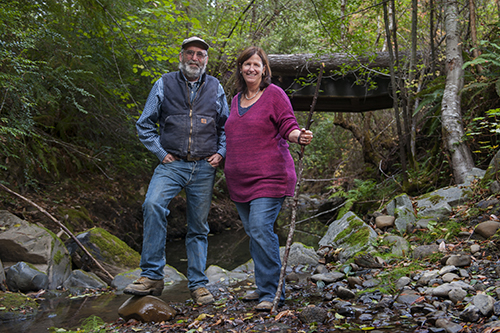 The rangeland is managed using a rotational grazing program that considers the movement of cattle to balance the livestock management goals, grass growth and the nutritional needs of the cattle. In the mid-80s, the Moores began calving based on the seasonality of the natural environment, using the energy from the sun to grow grass and harvest it with livestock. Moving the calving season improved reproductive efficiency and coincided with the spring grass growth and the time when the cattle have the highest nutritional needs.
The rangeland is managed using a rotational grazing program that considers the movement of cattle to balance the livestock management goals, grass growth and the nutritional needs of the cattle. In the mid-80s, the Moores began calving based on the seasonality of the natural environment, using the energy from the sun to grow grass and harvest it with livestock. Moving the calving season improved reproductive efficiency and coincided with the spring grass growth and the time when the cattle have the highest nutritional needs.
Wildlife habitat is abundant throughout the ranch. Black-tailed deer, black bear, mountain lions and foxes are frequent visitors. The ranch also has multiple watercourses, including Ellison Creek, Star Creek and Grouse Creek, all of which are tributaries to the North Fork of Yager Creek.
The Moores voluntarily acquired a Non-Industrial Timber Management Plan, which provides regulatory assurances to the landowner in exchange for ensuring that timber is harvested in a sustainable manner and commits to an uneven aged management of their forests. The Moores plant approximately five trees for every one harvested – ranging from 3,000 to 5,000 trees each winter. Their latest project will restore approximately 150 acres of native black and white oak populations in partnership with the U.S. Fish and Wildlife Service.
Dina currently leads a local watershed group, the Yager/Van Duzen Environmental Stewards (YES) with her ranching neighbors. The group collaborated with the U.S. Environmental Protection Agency during development of the Total Maximum Daily Load for sediment impairment of the Van Duzen, allowing EPA to conduct assessments on 80,000 acres of privately owned ranches. Over 15 years, the Moores and other YES families have made improvements on more than 400 miles of ranch roads, reducing enough sedimentation to fill more than 16,000 dump trucks.
“Lone Star Ranch continues to provide an example of environmental excellence and economic sustainability for other ranchers in their region and throughout the West,” said Daniel Macon, UC Davis Rangelands, Department of Plant Sciences. “They successfully balance ecological and production goals in all aspects of their operation.”
 Sign In
Sign In
 Sign In
Sign In
